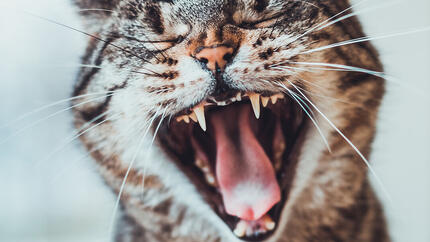


Being a cat owner can be difficult when it comes to health issues – cats are notoriously secretive and can try to hide when they are in pain. This means you need to be on the lookout for symptoms that something is wrong. And dental issues can be a common problem.
In this article, we’ll look at a condition called stomatitis and how to spot the signs of a dental health issue.
What is stomatitis in cats?
Stomatitis in cats is a medical condition which causes severe inflammation to the mouth and gums of felines. This inflammation will look reddish in colour and cause cats a significant amount of pain. In some extreme cases, it can even cause bleeding in the mouth.
What causes stomatitis in cats?
Multiple factors are suspected to cause stomatitis in cats and the causes have still not been definitively identified. Many believe the main cause of feline stomatitis is viral infections as many cats with stomatitis have a concurrent viral infection, particularly with a virus called 'calicivirus'. Plaque and calculus are also thought to be an important contributory factor.
What are the symptoms of stomatitis in cats?
There are a number of different clinical signs you can look for if you think your cat may be suffering from feline stomatitis. If you notice any of these, it’s important to take them to the vet for a check-up as soon as possible.
1. Inflamed and bleeding gums
Severely inflamed gums are a key sign that your cat may be suffering from feline stomatitis. When the gums become inflamed, they will turn red and start to swell. If left untreated the gums may also begin to bleed. This inflammation is not confined to just the gum either – other areas around the mouth such as the back of the throat can also become inflamed and ulcers can also develop.
2. Weight loss
Another indication that your cat may be suffering from feline stomatitis is rapid weight loss. This is because the inflammation and swelling in the mouth will cause a significant amount of pain and discomfort, which may cause your cat to eat very slowly or eventually stop eating altogether. One sign to look out for is a cat who is running to their bowl because they are hungry but then struggling to eat the food and leaving most or all of it. This can be particularly common when cats are eating dry food compared to wet.
3. Excessive drooling
Feline stomatitis can often cause excessive drooling in cats. Unlike dogs, drooling is not something that is very common in cats and is often a sign of pain. This makes it easier to spot as a warning something could be wrong with your cat’s dental health.
4. Lack of grooming
Many cats with stomatitis will begin to groom themselves less and less. This is because cats use their tongue and mouth to groom and since feline stomatitis can cause a lot of pain which makes grooming extremely uncomfortable. Sometimes you may not notice your cat grooming less but will see the signs instead, such as a matted coat.
5. Bad breath
Bad breath is very common in cats with stomatitis. When checking for bad breath it’s important to understand it is not always an indicator of disease. However, stomatitis leaves a particularly foul stench that is usually easily noticeable.
Treatment for stomatitis in cats
The first step to treating stomatitis in cats is to take them to your local vet. Your vet will be able to examine them to determine whether they have any dental disease, and if so, how severe this disease is. They will also be able to advise on the best treatment options.
1. Antibiotics
One treatment your vet may suggest to you is antibiotics. Antibiotics are sometimes used to regain control in a flare-up of disease and to control secondary bacterial infections which may otherwise worsen the inflammation and pain. Antibiotics can support the improvement of feline stomatitis which in turn will reduce inflammation and pain. Once gone, your cat’s condition will need to be monitored as it can flare up again. Antibiotics are not advised long term - only during flare-ups.
2. Steroids
Steroids can be an effective way to treat stomatitis in cats. However, they tend to be reserved for severe cases to regain control during a flare-up.
3. Non-steroidal anti-inflammatory drugs
Another common treatment for feline stomatitis is non-steroidal anti-inflammatory drugs otherwise known as NSAIDs. These drugs are used to reduce inflammation along with pain.
4. Tooth removal
If the feline stomatitis has progressed too far the best course of treatment may be tooth removal. Extracting the teeth around the inflamed tissue will reduce the inflammation along with the number of bacteria in your cat’s mouth. In extreme cases, a large number of teeth may need to be extracted in order to control the disease.
If you’re looking for more cat dental care advice, check out our guide, next!
Shop the Dentalife Cat range:
Related articles by Dentalife











